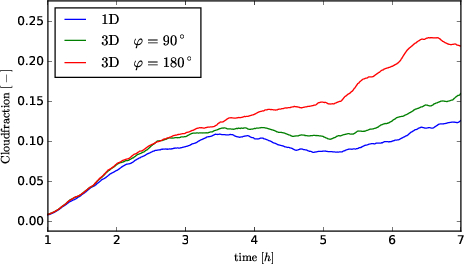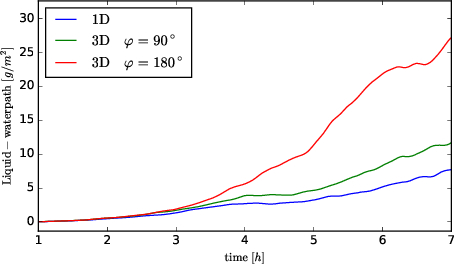In The role of 1-D and 3-D radiative heating in the organization of shallow cumulus convection and the formation of cloud streets I simulated plenty of shallow cumulus convection with varying solar zenith angles, wind speeds and surface properties to investigate how radiation might interfere with the organization of convection.
An example of such simulations can be viewed in the following short movie where two identical situations evolve with only one difference. On the left, we have the sun shining from the south(bottom) whereas on the right, the sun is located in the west(left). Volume rendering of liquid water content(blue) and net surface solar irradiance(orange/reds), i.e. cloud shadows(green)
Another aspect however, which was deliberatly not tackled in the above mentioned study is, how the organization influences the basic evolution of the simulations. Interestingly, if we have a look at those two simulations above, we find that the organized convection(\(\phi=180^\circ\)) is far more efficient in the vertical boundary layer transport processes. This finding seems to be a robust feature of simulations where the solar azimuth angle and the wind speed are aligned perpendicular and is robust with respect to modelling systems. E.g. so far we found this behaviour in UCLA-LES(shown here), in WRF simulations as well as in DALES, in the work of Menno.

 Cloud fraction and mean liquid water path for the above simulations with 1D radiation calculations and 3D TenStream simulations with varying azimuth angles.
\(\phi=180^\circ\) is sun shining from the left, \(\phi=90^\circ\) is shining from bottom.
Cloud fraction and mean liquid water path for the above simulations with 1D radiation calculations and 3D TenStream simulations with varying azimuth angles.
\(\phi=180^\circ\) is sun shining from the left, \(\phi=90^\circ\) is shining from bottom.